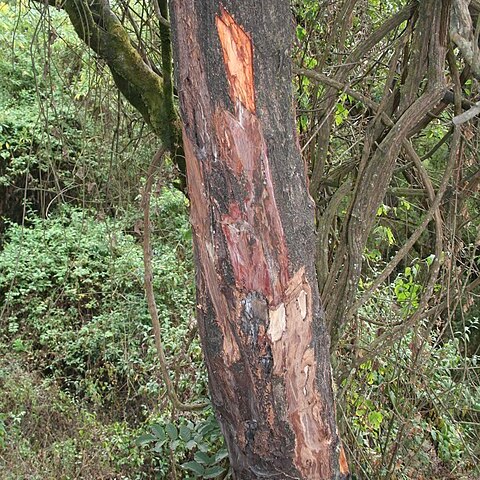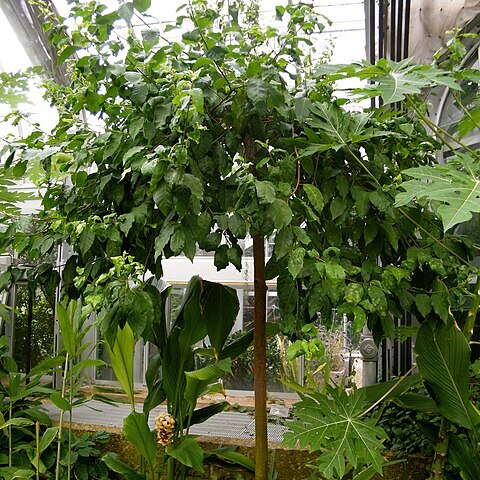Leaves petiolate; lamina (4)6–11(15) x 2–4(5·5) cm., elliptic, lanceolate-elliptic or oblong-lanceolate, glabrous, coriaceous or subcoriaceous, the apex obtuse to subacuminate, the base broadly cuneate to rarely rounded, margins coarsely crenate-serrate to subentire with dark glandular dots in the incisions (the most proximal gland on one or both margins of the leaf sometimes conspicuous); petiole 1–2 cm. long, channelled, often reddish; stipules ± linear, 1·5–2·0 cm. long, caducous.
Evergreen tree, up to 24 m high; unarmed. Leaves simple; blade ovate to elliptic, 50-110 x 25-40 mm, margins finely toothed, dark green and glossy above, paler below; petioles pinkish, 10-20 mm long. Flowers: white; Dec.-Jun. Fruit spherical, ± 10 mm in diameter, cherry-red.
Racemes usually solitary, 2–5(8) cm. long, 7–15-flowered, arising from the axils of scales at the base of lateral shoots which may also produce leaves in their upper part; peduncle usually 5–10 mm. long; pedicels (3)5–7(10) mm. long; bracts triangular, small, soon caducous.
An evergreen tree. It grows 25 m wide. The trunk can be 1 m across. It can be 10 m before branching. The crown is round. The limbs are large. The bark is almost black and very rough. The flowers are greenish-white. The fruit are purple.
Calyx-tube ± cyathiform, (3·0)3·5–4·0(5·0) mm. in diameter at the mouth, rather fleshy, glabrous outside, usually hairy inside; calyx-lobes 1–1·5 mm. long, triangular, glabrous except for the ciliate apex.
Evergreen tree, up to 24 m high. Leaves simple, ovate to elliptic, dark green and glossy above, paler below, margin finely toothed, petiole pinkish. Fruit spherical, 10 mm in diameter. Flowers white.
Fruit 5–8 x 8–12 mm., transversely ellipsoid, broader than long, slightly didymous and thus appearing as if 2-locular, dry, usually glabrous, red to purplish-brown.
Petals up to 2 mm. long, creamy-white, elliptic to oblong, reflexed, hairy abaxially especially towards their margins and sometimes adaxially also.
A much-branched evergreen tree c. 10 (up to 25) m. high, or rarely a shrub 3–5 m. tall, entirely glabrous except for the flowers.
Ovary ± ovoid, sparsely longhaired; style c. 1·5 mm. long, sparsely haired; stigma peltate, slightly 2-or 3-lobed.
Stamens 25–35; filaments c. 1·5 mm. long, glabrous; anthers didymous, 0·5–1·0 mm. long.
Tree to 24 m. Leaves elliptic, toothed. Flowers in axillary racemes, white, fragrant.
Perianth (4)5(6)-merous, sometimes irregularly so.
Bark dark brown to grey, rugged.



